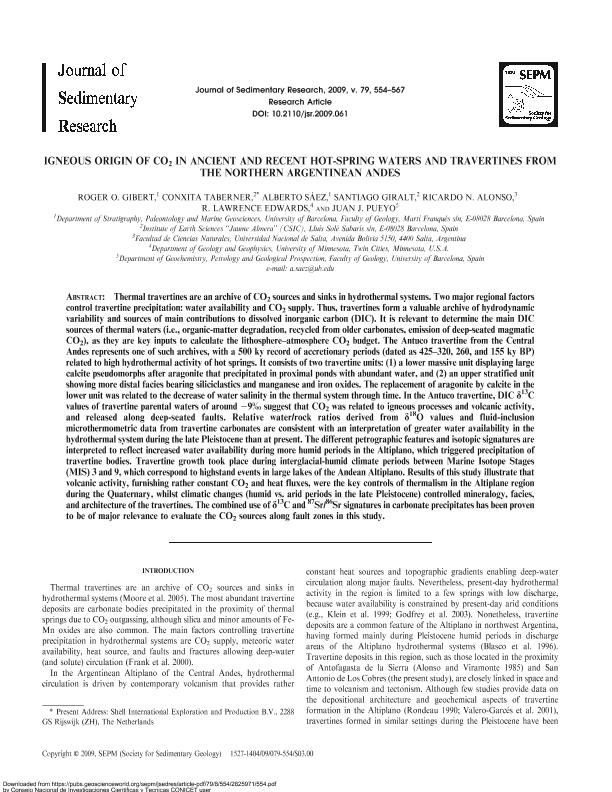Artículo
Igneous origin of Co 2 in ancient and recent hot-spring waters and travertines from the northern argentinean andes
Gibert, Roger O.; Taberner, Conxita; Sáez, Alberto; Giralt, Santiago; Alonso, Ricardo Narciso ; Edwards, Lawrence R.; Pueyo, Juan J.
; Edwards, Lawrence R.; Pueyo, Juan J.
 ; Edwards, Lawrence R.; Pueyo, Juan J.
; Edwards, Lawrence R.; Pueyo, Juan J.
Fecha de publicación:
07/2009
Editorial:
Society for Sedimentary Geology
Revista:
Journal of Sedimentary Research - (Print)
ISSN:
1527-1404
e-ISSN:
1938-3681
Idioma:
Inglés
Tipo de recurso:
Artículo publicado
Clasificación temática:
Resumen
Thermal travertines are an archive of CO 2 sources and sinks in hydrothermal systems. Two major regional factors control travertine precipitation: water availability and CO 2 supply. Thus, travertines form a valuable archive of hydrodynamic variability and sources of main contributions to dissolved inorganic carbon (DIC). It is relevant to determine the main DIC sources of thermal waters (i.e., organic-matter degradation, recycled from older carbonates, emission of deep-seated magmatic CO 2), as they are key inputs to calculate the Iithosphere-atmosphere CO 2 budget. The Antuco travertine from the Central Andes represents one of such archives, with a 500 ky record of accretionary periods (dated as 425-320, 260, and 155 ky BP) related to high hydrothermal activity of hot springs. It consists of two travertine units: (1) a lower massive unit displaying large calcite pseudomorphs after aragonite that precipitated in proximal ponds with abundant water, and (2) an upper stratified unit showing more distal facies bearing siliciclastics and manganese and iron oxides. The replacement of aragonite by calcite in the lower unit was related to the decrease of water salinity in the thermal system through time. In the Antuco travertine, DIC δ 13C values of travertine parental waters of around -9‰ suggest that CO 2 was related to igneous processes and volcanic activity, and released along deep-seated faults. Relative water/rock ratios derived from δ 18O values and fluid-inclusion microthermometric data from travertine carbonates are consistent with an interpretation of greater water availability in the hydrothermal system during the late Pleistocene than at present. The different petrographic features and isotopic signatures are interpreted to reflect increased water availability during more humid periods in the Altiplano, which triggered precipitation of travertine bodies. Travertine growth took place during interglacial-humid climate periods between Marine Isotope Stages (MIS) 3 and 9, which correspond to highstand events in large lakes of the Andean Altiplano. Results of this study illustrate that volcanic activity, furnishing rather constant CO 2 and heat fluxes, were the key controls of thermalism in the Altiplane region during the Quaternary, whilst climatic changes (humid vs. arid periods in the late Pleistocene) controlled mineralogy, facies, and architecture of the travertines. The combined use of δ 13C and 87Sr/ 86Sr signatures in carbonate precipitates has been proven to be of major relevance to evaluate the CO 2 sources along fault zones in this study.
Archivos asociados
Licencia
Identificadores
Colecciones
Articulos(CCT - SALTA-JUJUY)
Articulos de CTRO.CIENTIFICO TECNOL.CONICET - SALTA-JUJUY
Articulos de CTRO.CIENTIFICO TECNOL.CONICET - SALTA-JUJUY
Citación
Gibert, Roger O.; Taberner, Conxita; Sáez, Alberto; Giralt, Santiago; Alonso, Ricardo Narciso; et al.; Igneous origin of Co 2 in ancient and recent hot-spring waters and travertines from the northern argentinean andes; Society for Sedimentary Geology; Journal of Sedimentary Research - (Print); 79; 8; 7-2009; 554-567
Compartir
Altmétricas



